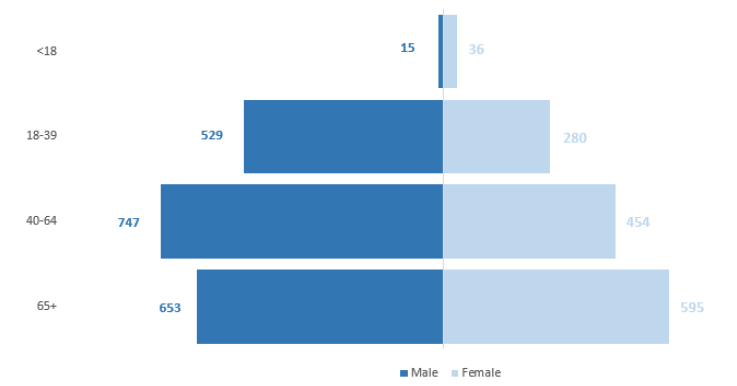Inpatient Census 2019: parts one and two
Results of the fifth Mental Health & Learning Disability Inpatient Census and Out of Scotland NHS Placements Census, 2019.
3. All patients treated in NHS Scotland facilities (Summary)
- 59% of patients in the 2019 Census were male, while for those aged 18 - 39 years this increased to 65% of patients
- Continuous improvements to ethnicity data recording has been noted. The majority of patients (80%) identified as white Scottish
- Most patients (86%) did not have any dependents in the 2019 Census
This section summarises demographic information for all patients occupying a mental health, addiction and learning disability bed in NHS Scotland at the 2019 Census. More detailed information on specific groups; adults (18+), children and young people (<18) and forensic patients, follows in later sections.
- The majority of patients in the 2019 Census were male (59%) and this proportion has changed little since the 2016 Census, flucuating only by one percentage point. The difference is most pronounced for those aged 18-39 years where 65% are male while the gap narrows for those aged 65 and over (52% male versus 48% female). Only for those aged under 18 are there more females (69%).
Figure 4: There are more males than females occupying an inpatient bed at the 2019 Census at all age groups except under 18's
Psychiatric, Addiction or Learning Disability Inpatient Beds, NHS Scotland, 2019 Census

- Most patients were aged 65 or over (38%) or between 40 to 64 years (36%) and this pattern has changed little since the 2016 Census. However, there has been a small decrease in the proportion of 65 and overs since 2016 of 3 percentage points.
- The average (mean) age of a patient in the 2019 Census was 55 years old, a slight decrease on the average of 57 years in the 2016 Census.
- The majority of patients (40%) in the 2019 Census were admitted due to a therapeutic/clinical crisis. A further 12% were admitted for diagnostic reasons, while 6% were admitted for rehabilitation.
- There has been a notable improvement in the recording of ethnicity data since the 2016 Census. At that point, 7% of patients were returned as refused or not known, however, this has dropped to 2% in the 2019 Census.
- The majority of patients (80%) identified as white Scottish in the 2019 Census. An additional 14% of patients identified as other white. Asian, Asian Scottish or Asian British made up 2% of the 2019 Census while African, African Scottish or African British made up a further 1%. These proportions are relatively unchanged from previous years.
- More than half (53%) of patients in the 2019 Census had never been married nor registered in a civil partnership. This proportion is a 5 percentage point increase on the 2018 Census.
- Most patients (86%) in the 2019 Census did not have any dependents. However, 6% of patients had a working age adult dependent and a further 5% had at least one child dependent.
- In the 2019 Census, 36% of patients were retired which is a 5 percentage point decrease from 2016. This change likely reflects the change in age demographics described above. The proportion of patients who were unemployed was 47% in the 2019 Census, an increase of 3 percentage points. A further 4% of patients were not allowed to work, while 1% were students.
Contact
Email: SWStat@gov.scot
There is a problem
Thanks for your feedback